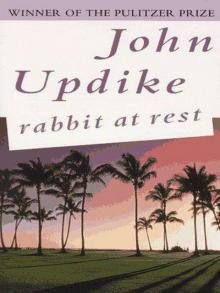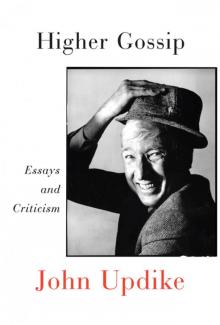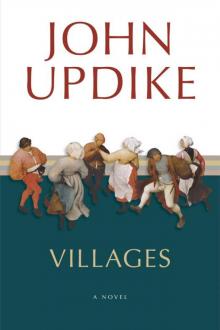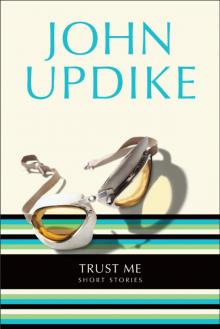- Home
- John Updike
Odd Jobs: Essays and Criticism Page 7
Odd Jobs: Essays and Criticism Read online
Page 7
Umberto Eco’s text is full of ironies, and motion pictures do not have leisure, generally, to be ironical. What in the novel is mandarin parody—two travelling monks as Sherlock Holmes and Watson, the isolated abbey as a closed “country house” for a classic murder mystery—the movie takes more or less straight; the clichés simply excite us, as they often have before. The plot is rather clearer than in the novel, because less surrounded by exposition and Latinate discourse, and the book’s central irony—a succession of murders that do not link up but turn out to be, like the Godless universe itself, the work of many chancy happenings—is lost in the visual tumble, one fright after another, that we as moviegoers expect. The movie makes less sense than only the most artful of suspense films, and we do not begrudge it its strain of incoherence, even to the miraculous escape of William from the burning library; he must have used the secret stairway carefully diagrammed in the novel but scarcely mentioned in the film, whose makers must have concluded that one secret passageway—the one leading from the chapel altar, with a carved skull’s eyes as its door latch—was enough. In place of diagrams and deductive brilliance, we have the brilliance of the set designers who constructed the labyrinthine library with its big pale vellum-bound volumes, its musty angled surfaces, and its Piranesiesque tangle of staircases. The set is splendid but its conflagration is relatively perfunctory; the scholarly Eco’s vision of a massive and sickening loss of historic texts cannot be shared by the makers of films, for whom waste—of “takes,” of abandoned and ruthlessly revised scripts, of time, of money—is inextricable from the artistic process. A movie is itself a flickering flame, a piece of visible consumption.
Yet movies have their rigors: in a book, with its negligible budget, the author’s wishes dominate; but in a motion picture the wishes of the audience shape the product. What we wish to happen, will happen. As film-goers we know that the abbey must burn, because it is hopelessly polluted, and its confusions can be satisfyingly dealt with only through destruction. The primitive ethical logic of film demands, too, that the villain of the piece, in this case the inquisitor Bernard Gui, be dealt a bloody death. The torturer falls from a great height and is many times pierced by a hay rake. The book, on the other hand, merely lets Gui sink back into the morass of history, which is so replete with villains that none can be dignified with punishment.
Movie logic demands as well that the nameless peasant girl who impulsively and wordlessly (for she speaks a dialect remote from Latin) bestows herself upon young Adso be spared the death on the pyre to which Eco, with historically correct heartlessness, casually and irrevocably consigns her. But in the rigid ethical system, based upon wish-fulfillment, that controls the myth-making operations of the cinematic art, she must be saved and glorified, not just because Adso loves her. It is we who love her: how, once she has, in the movie’s one sex scene, so charmingly shown us her breasts and buttocks, can we watch her burn, or think of her burning? Even the ferocity of Bergman’s films, wherein animals and fish are killed before the camera, balks at the sacred inviolacy of the bared female form; in The Seventh Seal, the condemned young witch survives. Further, Adso prays to the Madonna that the girl be spared, and in our cinematic universe not only is sexual energy always conserved but prayers are always answered. We viewers of The Name of the Rose can scarcely withhold tears of gratitude and religious hysteria at the sight, appropriately phallic, of the deserted stake where the movie’s lone heroine has been somehow saved. Saved, the movie tentatively suggests, by a peasant uprising, in behalf of lovely young witches and the chthonian fertility they represent.
After touch, the visual is the supreme erotic sense, and there is no keeping sex marginal in a motion picture. If it is there at all, it will overflow the screen, and demand to rule the plot. An erotic incident minor (and pedantically overwritten) in the novel irresistibly becomes central in the movie, and though Adso in the end rejects the live girl in favor of monkish celibacy, this is movie logic also, for thus he enshrines her forever in his memory. He even, in the most surprising twist given the novel by the moviemakers, makes her illiterate silence the point of the title: she is the rose who never acquired a name. And perhaps Adso’s typical romantic deferral of perishing actuality, this heretical (according to Denis de Rougemont) act of eternalization through denial, is not unfairly read into the novel’s title, taken from the Latin “stat rosa pristine nomine, nomina nuda tenemus.” The rose remains pristine in name; we hold (keep) her name (the idea of her) naked (pure).
Overboard on Overboard
I SAW A NUMBER of last season’s well-reviewed movies, and some, like Moonstruck and The Last Emperor, lived up to their notices, and others, like Broadcast News and My Life as a Dog, seemed to me to misfire, though their good intentions were obvious. But the motion picture I liked best was one I went to impulsively, at the local second-run house, with no memory of its reviews save the dismissive observation, somewhere, that Goldie Hawn should pick her material better. I went to Overboard expecting only that it would contain Goldie Hawn and would attempt to be funny and at least wouldn’t depress me. In the event, it moved me, and I feel I should, apologetically, try to explain why.
First, Goldie Hawn. I used to love her on Laugh-In, which was one of the Vietnam era’s few light-hearted spots. She and Judy Carne would revolve their bikini-bared bodies, painted with slogans in that heyday of angry graffiti, and it would seem that anger wasn’t everything, and that thanks to laughter and bimbos we might survive. Her face, on the verge of pop eyes and buck teeth, was a semi-comic valentine, surrounded by tumble-dried blond hair. We go to movies to see a star, just as they did in the Thirties—a dependably familiar presence mounted in some new, but not disturbingly novel, vehicle.
Next, the theatre. The Cabot Theatre in Beverly is a consciously preserved and considerably restored old-fashioned small-city movie palace, with a stage, a balcony, a uniformed doorman, and a player piano in the lobby; it puts anybody over fifty in a nostalgic, tolerant frame of mind. Admission costs three dollars and the smallest size of popcorn only a dollar, as opposed to twice that at the malls. The floor doesn’t stick to your shoes, an usher will lead you to your seat with a flashlight, and you sit there with the simple heart of a child.
Then the movie. Goldie Hawn, an impossibly spoiled rich bitch, falls off her yacht and, when rescued, is suffering from amnesia so total that a lowly beer-swilling carpenter (played by Kurt Russell) whom she has recently offended persuades her that she is his wife and must come keep his house and raise his four sons by (in fact) a wife three years dead. The joke and miracle of it is that, though equipped with an incongruously tony accent and a total innocence of housekeeping skills, she gradually submits to the assigned role, falls in love with her false husband, and finds happiness.
Sound familiar? The story touches timeless themes—the taming of the shrew, and the war of the sexes. It concerns, like the classic romantic comedies of the Thirties, education—the thawing, through a man’s rough care, of a Hepburnesque ice princess. Hawn, cuddly and woozy, is no Hepburn, which makes the transformation rather more affecting: it is her real self she is restored to. When we see her on the yacht, swaggering about with her hair pulled in a tight chignon and her lips twisted in an upper-class sneer, we do not recognize her as Hawn—at least I didn’t, though I knew I had paid three dollars to see her in a movie. As soon as she falls overboard, and is found with scraggly hair half-hiding her face, we know who she is, even if she does not.
Considerable cruelty attends her initiation into being the carpenter’s house-slave. He and his four sons, who all seem to be crowding adolescence, spatter her with food and fire-extinguisher foam, dunk her in a rain barrel, dress her in grotesquely ill-fitting clothes, and wear her to a delirious frazzle. The abuse is drastic, but, then, her sins, as a rich bitch, have been shown as extreme; when still in her right mind she refused to pay Russell for a cunning shoe-closet he has built for her on the yacht, pushed him overboard, and, worst of all, threw his tools a
fter him into the ruinous saltwater. His revenge has limits, however: he shows his basic decency by not forcing the sexual side of her wifely services, and thereby the film keeps its own honor; a rape, however finagled, would put the moral onus on the poor rather than the rich. Also, Hawn has a legitimate husband (played by Edward Hermann, fresh from his husbandly stint in Mrs. Soffel), who, though a callow snob, must be figured into the final moral accounting.
Her basic decency comes into play when, against all her pre-amnesia conditioning, she takes hold in the house and becomes a mother to the motherless boys, defending them from a shrewish schoolteacher, rubbing calomine lotion on their poison-oak rash, and teaching the illiterate youngest to read. The slovenly widower’s shack yields to the ordering, cleansing female touch; her own costumes move from grotesque misfit to K-Mart chic. Russell, too, suffers some changes: he is surprised into a decent embarrassment as she makes his lies come true, and then into real affection as she settles at his side. His attempts to confess the truth are frustrated by his sons, who have come to need the mock mother, and by a buddy, who tells him the mock marriage is a good one. Her real husband belatedly appears, and her amnesia simultaneously falls away, but we have no doubt that nature, now that it is aroused, will triumph over nurture and come to true love’s rescue.
Hollywood has always voted for nature over nurture, for love over social position. In this it confirms us in our wishes, and assures us of the soundness of our instincts. Overboard is about bad nurture: Russell, in being wifeless and permissive, is a bad father, and Hawn’s mother a bad mother in raising a little rich bitch. This mother—a New Yorker shown in her outrageously posh apartment surrounded by pillows and dog manicurists—figures not so much in the plot as in the moral equation. For raising her daughter poorly, she must be punished, albeit lightly; twice she is shown being thrown out of bed by the swervings of the yacht as the plot zigzags toward resolution. The husband, on the other hand, has his punishment foreordained, in the loss of his star of a wife; therefore he must be established as deserving punishment. So we see him decline to rescue her on the day after she fell overboard, and instead embark on months of floating orgy with some Los Angeles tarts. He deserves to be left, the mother deserves her lumps, the boys deserve a mother, the lovers deserve each other, and we the audience deserve to congratulate ourselves for feeling so pleased about it all.
All this moral rigor would be merely mechanical, of course, if Hawn and, to a lesser extent, Russell, who in real life lives with her, did not bring warmth to the acting, and give their educations—their transformation into loving adults—a rounded-out, on-screen reality. In Broadcast News, by contrast, the educations of the romantic principals feel incomplete, and we are frustrated by the heroine’s inability to find happiness with either man. In My Life as a Dog, the boy’s education or maturation is anticipated but never arrives through the odd muddle of a dying, receding mother and repeated sexual assaults by too many pubescent girls. Instead of becoming human, he becomes a dog, barking crazily.
Moonstruck balances its accounts and gives us our way, but with its tongue in its cheek; it is a consciously old-fashioned—charmingly so—movie. Overboard, for all of its slapstick, takes itself more seriously, and moves us without a wink, especially at the moment when the heroine, suddenly faced with two husbands and two lives, tries to puzzle her way to the truth of who she is. We allow confusion-of-identity plots their implausibilities because they bring to life, in a world that tends to lock us in, the possibilities of reversal and renewal. Like The Last Emperor, Overboard deals with the poignant mystery of being oneself: a puzzled tot thrust into the condition of emperor and buffeted by post-imperial history, and a young woman born into blood-curdling privilege and then dumped for her salvation into the lower middle class. We are so persuaded, in Overboard, of the moral and sexual superiority of beer over champagne that it comes as a shock, at the end, to learn that the money belongs to Goldie Hawn’s Cinderella, and that she will bestow it upon her carpenter-prince. How will he avoid, then, becoming as fatuous and effete as the former husband? Already, one of his sons is heard demanding a Porsche. This final fillip, perhaps intended as a casual sop to our notorious Eighties greed, disturbs the fable so nicely constructed. How can she, now knowing herself to be rich, slip back into the healthy rigors of wifely servitude? Money is the root of all evil in Overboard, and its final overthrow needs a Nineties sequel, in which the money goes overboard.
* Why not name them, nearly three decades down the road? Howard Lindsay, Harry Golden, Walt Kelly, and William K. Zinsser. Only Zinsser and I still live.
† The Witches of Eastwick, concerning which I wrote the agent responsible for the deal, on July 10, 1987, “I have seen the movie and after surviving the bursts of grossness in the beginning, and the echoes of my own dialogue, I settled into the incoherent fantasy of it all and especially admired the skating around in pink balloons and the very vivid pomegranate chewing [an episode, owing nothing to the novel, in which Jack Nicholson, as the devil-figure Darryl Van Horne, torments the excessively fertile Michelle Pfeiffer by biting into a ripe pomegranate that, in perfect illustration of the principle of sympathetic magic, transfers a griping agony to her uterus]. The less it resembled my book, the better I felt. And something about the war between the sexes did carry over, in quite different form. It is not a movie I would see twice but I did sit through to the end, whereas I couldn’t make myself read the script at all.”
ENVIRONS
Fictional Houses
NOT ONLY do fictional characters have to be supplied with faces and life histories, speech rhythms and psychologies; they must have houses to live in:
By daylight, the bower of Oak’s new-found mistress, Bathsheba Everdene, presented itself as a hoary building, of the early stage of Classic Renaissance as regards its architecture, and of a proportion which told at a glance that, as is so frequently the case, it had once been the manorial hall upon a small estate.… Fluted pilasters, worked from the solid stone, decorated its front, and above the roof the chimneys were panelled or columnar, some coped gables with finials and like features still retaining traces of their Gothic extraction.
Hardy had been trained as an architect, and in Far from the Madding Crowd has no trouble embowering his heroine with a solidity subtly proportionate to her worth as a mate, and in agreeably animating her inherited home’s interior: “Lively voices were heard this morning in the upper rooms, the main staircase to which was of hard oak, the balusters, heavy as bed-posts, being turned and moulded in the quaint fashion of their century, the handrail as stout as a parapet-top, and the stairs themselves continually twisting round like a person trying to look over his shoulder.” Our story takes place, we are made certainly to feel, in enduring settings that long predate and will long outlast these momentary actors; Hardy’s most ardent evocation is of the stone barn, four centuries old:
Standing before this abraded pile, the eye regarded its present usage, the mind dwelt upon its past history, with a satisfied sense of functional continuity throughout.… The lanceolate windows, the time-eaten archstones and chamfers, the orientation of the axis, the misty chestnut work of the rafters, referred to no exploded fortifying art or worn-out religious creed.…
To-day the large side doors were thrown open towards the sun to admit a bountiful light to the immediate spot of the shearers’ operations, which was the wood threshing-floor in the centre, formed of thick oak, black with age and polished by the beating of flails for many generations, till it had grown as slippery and as rich in hue as the state-room floors of an Elizabethan mansion.
History of a more hurried, borrowed sort shapes the home of Mrs. Manson Mingott, so daringly located (in the 1870s) above New York’s 34th Street: “The house in itself was already a historic document, though not, of course, as venerable as certain other old family houses in University Place and lower Fifth Avenue. Those were of the purest 1830, with a grim harmony of cabbage-rose-garlanded carpets, rosewood consoles, round-arc
hed fireplaces with black marble mantels, and immense glazed bookcases of mahogany; whereas old Mrs. Mingott, who had built her house later, had bodily cast out the massive furniture of her prime, and mingled with the Mingott heirlooms the frivolous upholstery of the Second Empire.” Edith Wharton’s splendid eye for decor was not blind to the potential oppression of the correct and the expected; Mrs. Mingott, though immobilized by obesity, is one of the few free spirits in The Age of Innocence. The novel’s hero, Newland Archer, nearly swoons at the Countess Olenska’s unconventional room appointments, her “small slender tables of dark wood” and stretch of red damask: “The atmosphere of the room was so different from any he had ever breathed that self-consciousness vanished in the sense of adventure.” His mind casts ahead to the house his prospective father-in-law has lined up for him:
… the house was built in a ghastly greenish-yellow stone that the young architects were beginning to employ as a protest against the brownstone of which the uniform hue coated New York like a cold chocolate sauce; but the plumbing was perfect.… The young man felt that his fate was sealed: for the rest of his life he would go up every evening between the cast-iron railings of that greenish-yellow doorstep, and pass through a Pompeian vestibule into a hall with a wainscoting of varnished yellow wood.

 Picked-Up Pieces: Essays
Picked-Up Pieces: Essays Bech: A Book
Bech: A Book Roger's Version: A Novel
Roger's Version: A Novel Seek My Face
Seek My Face The Carpentered Hen
The Carpentered Hen Pigeon Feathers: And Other Stories
Pigeon Feathers: And Other Stories Rabbit Is Rich
Rabbit Is Rich The Afterlife: And Other Stories
The Afterlife: And Other Stories Rabbit at Rest
Rabbit at Rest The Witches of Eastwick
The Witches of Eastwick Gertrude and Claudius
Gertrude and Claudius Bech Is Back
Bech Is Back Hub Fans Bid Kid Adieu: John Updike on Ted Williams
Hub Fans Bid Kid Adieu: John Updike on Ted Williams Marry Me: A Romance
Marry Me: A Romance Museums and Women: And Other Stories
Museums and Women: And Other Stories My Father's Tears and Other Stories
My Father's Tears and Other Stories Collected Poems, 1953-1993
Collected Poems, 1953-1993 Trust Me: Short Stories
Trust Me: Short Stories Odd Jobs: Essays and Criticism
Odd Jobs: Essays and Criticism Rich in Russia
Rich in Russia Higher Gossip: Essays and Criticism
Higher Gossip: Essays and Criticism The Widows of Eastwick
The Widows of Eastwick In the Beauty of the Lilies
In the Beauty of the Lilies Rabbit, Run
Rabbit, Run The Early Stories: 1953-1975
The Early Stories: 1953-1975 Rabbit Redux
Rabbit Redux S.
S. Brazil
Brazil Toward the End of Time
Toward the End of Time The Centaur: A Novel
The Centaur: A Novel Assorted Prose
Assorted Prose Memories of the Ford Administration
Memories of the Ford Administration Terrorist
Terrorist Couples: A Novel
Couples: A Novel Bech at Bay
Bech at Bay The Music School: Short Stories
The Music School: Short Stories Villages
Villages S
S Roger's Version
Roger's Version Pigeon Feathers
Pigeon Feathers Higher Gossip
Higher Gossip Rabbit Redux r-2
Rabbit Redux r-2 Memories of the Ford Administration: A Novel
Memories of the Ford Administration: A Novel The Centaur
The Centaur Marry Me
Marry Me Picked-Up Pieces
Picked-Up Pieces Bech
Bech Rabbit Remembered
Rabbit Remembered Trust Me
Trust Me The Early Stories
The Early Stories Odd Jobs
Odd Jobs The Centaurus
The Centaurus The Afterlife
The Afterlife The Music School
The Music School Museums and Women
Museums and Women Couples
Couples